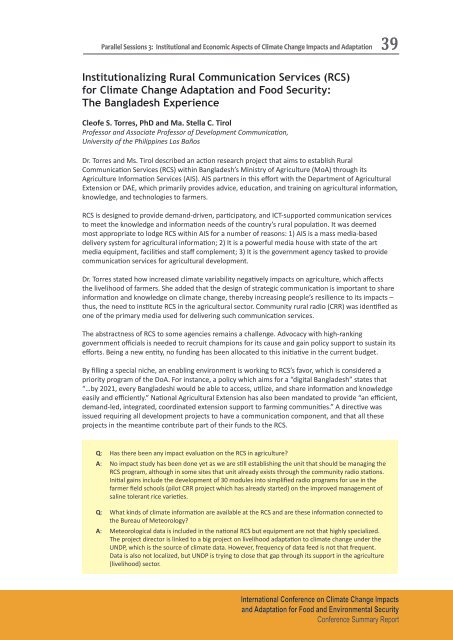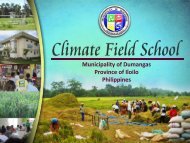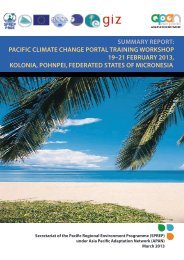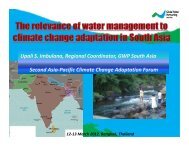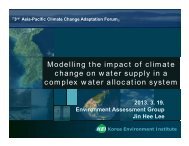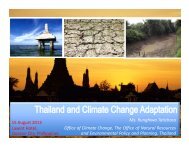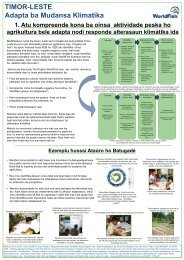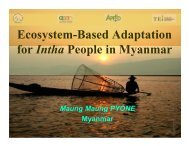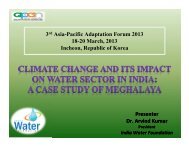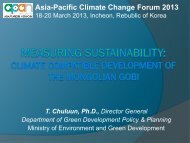PDF file (2.44 MB) - Asia Pacific Adaptation Network
PDF file (2.44 MB) - Asia Pacific Adaptation Network
PDF file (2.44 MB) - Asia Pacific Adaptation Network
Create successful ePaper yourself
Turn your PDF publications into a flip-book with our unique Google optimized e-Paper software.
Parallel Sessions 3: Institutional and Economic Aspects of Climate Change Impacts and <strong>Adaptation</strong>39Institutionalizing Rural Communication Services (RCS)for Climate Change <strong>Adaptation</strong> and Food Security:The Bangladesh ExperienceCleofe S. Torres, PhD and Ma. Stella C. TirolProfessor and Associate Professor of Development Communication,University of the Philippines Los BañosDr. Torres and Ms. Tirol described an action research project that aims to establish RuralCommunication Services (RCS) within Bangladesh’s Ministry of Agriculture (MoA) through itsAgriculture Information Services (AIS). AIS partners in this effort with the Department of AgriculturalExtension or DAE, which primarily provides advice, education, and training on agricultural information,knowledge, and technologies to farmers.RCS is designed to provide demand-driven, participatory, and ICT-supported communication servicesto meet the knowledge and information needs of the country’s rural population. It was deemedmost appropriate to lodge RCS within AIS for a number of reasons: 1) AIS is a mass media-baseddelivery system for agricultural information; 2) It is a powerful media house with state of the artmedia equipment, facilities and staff complement; 3) It is the government agency tasked to providecommunication services for agricultural development.Dr. Torres stated how increased climate variability negatively impacts on agriculture, which affectsthe livelihood of farmers. She added that the design of strategic communication is important to shareinformation and knowledge on climate change, thereby increasing people’s resilience to its impacts –thus, the need to institute RCS in the agricultural sector. Community rural radio (CRR) was identified asone of the primary media used for delivering such communication services.The abstractness of RCS to some agencies remains a challenge. Advocacy with high-rankinggovernment officials is needed to recruit champions for its cause and gain policy support to sustain itsefforts. Being a new entity, no funding has been allocated to this initiative in the current budget.By filling a special niche, an enabling environment is working to RCS’s favor, which is considered apriority program of the DoA. For instance, a policy which aims for a “digital Bangladesh” states that“…by 2021, every Bangladeshi would be able to access, utilize, and share information and knowledgeeasily and efficiently.” National Agricultural Extension has also been mandated to provide “an efficient,demand-led, integrated, coordinated extension support to farming communities.” A directive wasissued requiring all development projects to have a communication component, and that all theseprojects in the meantime contribute part of their funds to the RCS.Q: Has there been any impact evaluation on the RCS in agriculture?A: No impact study has been done yet as we are still establishing the unit that should be managing theRCS program, although in some sites that unit already exists through the community radio stations.Initial gains include the development of 30 modules into simplified radio programs for use in thefarmer field schools (pilot CRR project which has already started) on the improved management ofsaline tolerant rice varieties.Q: What kinds of climate information are available at the RCS and are these information connected tothe Bureau of Meteorology?A: Meteorological data is included in the national RCS but equipment are not that highly specialized.The project director is linked to a big project on livelihood adaptation to climate change under theUNDP, which is the source of climate data. However, frequency of data feed is not that frequent.Data is also not localized, but UNDP is trying to close that gap through its support in the agriculture(livelihood) sector.International Conference on Climate Change Impactsand <strong>Adaptation</strong> for Food and Environmental SecurityConference Summary Report


